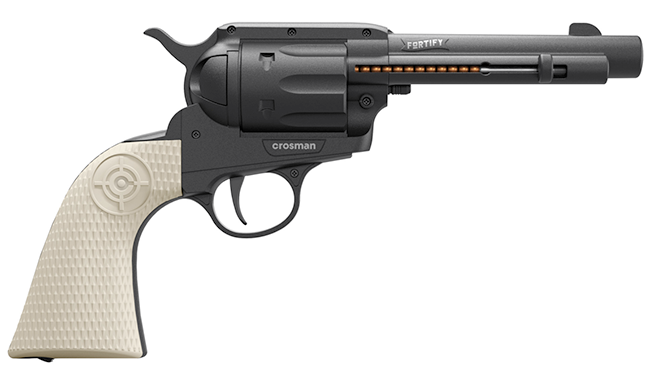
The Crosman Fortify BB pistol.
This report covers:
- Different
- Test-within-a-test
- Crosman Copperheads|
- Crosman Black Widow
- Discharge sound
- Magazine
- Shot count
- Trigger pull
- Summary
Today we look at the velocity of the Crosman Fortify BB pistol. We also look at something else that I have long wondered about and today is the day I find out. Let’s get started.
Different
The Fortify is sold as a single action revolver. Single action it is, but nothing revolves. The exterior looks like a Colt Single Action Army, but the Fortify is really an 18-shot BB pistol that’s dressed to look western.
Test-within-a-test
You may have noticed that I seldom use Crosman Copperhead BBs in my BB-gun tests. That’s because I don’t feel they are a premium BB. Let me show you why I say that.
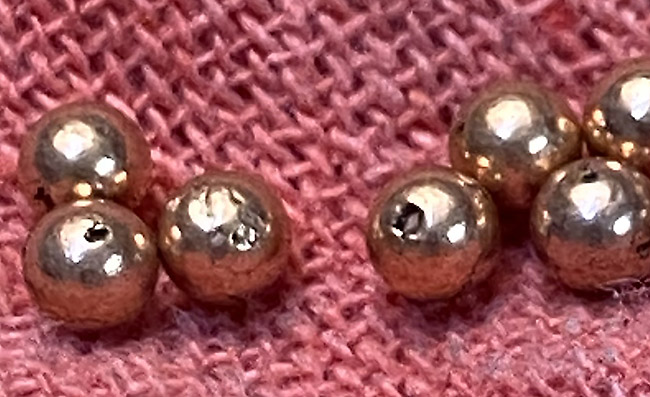
Copperhead BBs, just as they were poured from the container. Four of the seven BBs shown have imperfections in their surfaces.
Crosman Copperheads
There is a story in this. Several years ago I chastised myself for not using Copperhead BBs in more tests. I noticed that my bottle of Copperheads was many years old, so I bought a new bottle. Today this bottle may be four years old. I like to test ammunition made by the maker of the airgun, if possible, so since the Fortify is from Crosman I thought I’d test them.
But Crosman also sells the Black Widow BB. They source them from China, where all the finest BBs are produced. Copperheads are made in the USA and let me just say that if the machinery they are made on were alive it would qualify for Social Security. The Chinese machinery is new by comparison, so of course it does the job better.
So today’s test was not just a velocity test. It was also a stability test within a velocity test — Copperheads versus Black Widows.
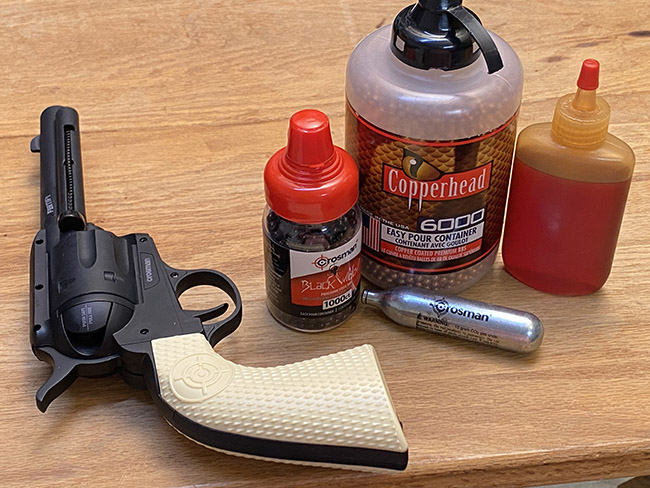
I tested the Fortify with both Crosman Copperheads and Black Widow BBs.
Let’s get started with the test. I installed a fresh Crosman CO2 cartridge and fired one shot to make sure it had pierced. Then the testing began.
The first BB tested was the Copperhead. Ten of them averaged 416 f.p.s. The Pyramyd AIR description says to expect a maximum of 335 f.p.s. from the Fortify and this is why we test. But the entire string shows a different story. Let’s look.
Shot……Vel.
1…………431
2…………405
3…………429
4…………417
5…………420
6…………415
7…………401
8…………420
9…………411
10……….413
There is a 30 f.p.s. spread in this string.
Crosman Black Widow
Now I tested the Black Widows. Ten averaged 389 f.p.s. Now let’s look at the string.
Shot……Vel.
1…………382
2…………388
3…………389
4…………393
5…………376
6…………411
7…………393
8…………389
9…………383
10……….388
This string has a 35 f.p.s. spread. We can therefore see that the Fortify is not that stable when it comes to velocity. I do see that the Black Widows did tend to stay around the average velocity more than the Copperheads, but the bottom line is both BBs are less than stable. I would like to see 10-15 f.p.s. maximum variation in a CO2 pistol.
Discharge sound
I recorded the discharge sound during the next shot string, that was a string to the end of the useable gas. At around the 50th shot the discharge was 101.7 dB. That’s probably the high end of a three rating on the 5-point Pyramyd AIR sound rating.
Magazine
I will report that the magazine loads easily, though you do have to drop each BB into the hole, one after the other. The magazine fed flawlessly throughout the test.
Shot count
All shooting reported today was done on the first and only CO2 cartridge I loaded. There was one shot in the first two strings that failed to register, so I started the shot count on number 22. I went back to Crosman Copperheads for the remainder of the test.
I arbitrarily said I would stop shooting when the velocity dropped below 275 f.p.s. The pressure drops off rapidly at that point and I didn’t want a BB stuck in the barrel.
Shot………Vel.
22………….did not register
23………….375
24………….418
25………….386
26………….388
27………….368
28………….404
29………….384
30………….383
40………….384
50………….374
60………….385
70………….345
80………….297
81………….295
82………….287
83………….282
84………….274
Trigger pull
The trigger on the Fortify I’m testing breaks cleanly at 6 pounds, even. It is a single stage trigger and I feel no creep in the pull. I do feel the trigger blade move slightly, but absolutely no pull.
Summary
The Crosman Fortify is testing well so far. Once I learned how the safety works (see Part 1) everything else is straightforward.
At the price of just over fifty dollars I think the Fortify offers a lot of value, though I want to see the accuracy before I confirm that.
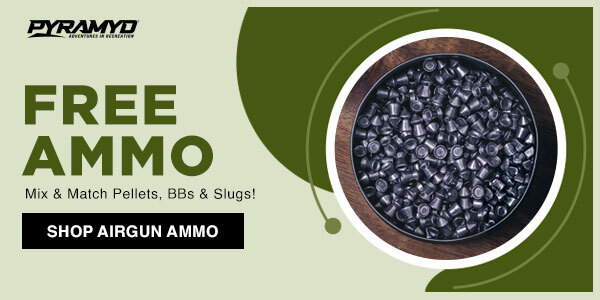
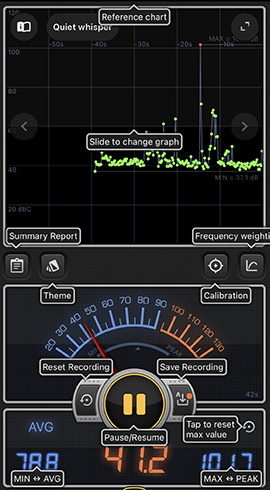
“…I think the Fortify offers a lot of value, though I want to see the accuracy before I confirm that.”
Roger that, BB!
It looks nice, and has good velocity, with a decent shot count.
My Daisy Buck can reliably take down cans at 15 yards, sometimes at 20.
If this pistol can at least do minute-of-soda-can at 10 yards, I’d call it a viable plinker.
Then again, what do I know? I’m not the Godfather of Airguns! 😉
Blessings to you,
dave
Dave,
Okay. That will be my new standard! Minute-of-soda/pop-can at 10 yards.
BB
12oz or 7oz for a challenge?
I’d settle for 12 oz, but 7 oz would be awesome! 😉
LOL! I like it! 🙂
If it’s pop can capable at 30 feet, I am getting one!
Good news everyone… Look what just arrived.
I had an unpleasant surprise yesterday when I found out that Diana 27s were made as smoothbores (I thought only the smaller 25s and 23s were available without rifling).
Luckily, this one has a rifled barrel. It also shoots fine (all shots on the target, enough room for adjustment in the front sight left).
I think this one has a little bit more “oomph” than my HW30S which makes sense as it was made in 1967 (the whole 7,5 joule thing started in 1970 in Germany). I think D27s should have around 9 joule. The shot cycle isn’t unpleasant at all.
So, you’re going to get your review 🙂
Stephan
Stephan,
That is really nice looking! I would not mind that one gracing my “collection” should you become tired of it. 😉 I do hope she shoots as nice as she looks.
I am looking forward to what you have to say about this fine little lady.
Stephan,
That’s great!
BB
Feral soda cans at 10 yards? I certainly hope so.
Though this is not fancy in function, it does look to be an inexpensive plinker. If it were not for my having two bb guns now and two pistols I would like to move on, I would give this some serious consideration myself.
Oops – Crosman Copperheads section – 2nd paragraph
Copperheads are made in the USA and let me just say that if the machinery they are made on were alive it would (be) qualify for Social Security. – remove be
RR,
Done. Good catch!
BB
BB, what are you using to record the sound? I have tried two different decibel meters without any success. (Although it could just be that they are set for slow and the gun report sound in question is short lived.) Thanks.
Elmer,
You need a decibel reader that captures the C scale, which is impulse sounds. My phone app is called DecibelX and costs $5 per month.
BB
Thanks, are you recording the sound and then evaluating it? I have just changed the response time on my phone app (dB Meter) from 500ms to 50ms. I will try it again to see if that helps.
BB,
that is not quite what the “C” scale is.
The A,B and C scales are standardised methods for weighting the frequency response (basically different curves). These are used because our hearing is not linear and we perceive things differently at different volume levels.
https://www.engineeringtoolbox.com/decibel-d_59.html
C is the “loud” scale and thus probably a good idea for testing guns.
The slow/fast/impulse weighting is its own thing and has to do with the way the readings are averaged in the time domain. A slow weighting might be good for adjusting loudspeaker levels while “impulse” is what you would want for a gun (for very obvious reasons).
https://www.noisemeters.com/help/faq/time-weighting/
So, “C scale” in addition to “impulse” would be the way to go.
Stephan
Stephan,
Okay, there’s something else BB doesn’t know. Thanks for the info.
BB
Thanks for the lesson on sound measurements.
Where and how do you orientate the microphone relative to the airgun to get the correct representative sound measurement?
I am using an iPhone with the app “NIOSH SLM”. I just changed the settings,
the frequency weighting to “C” and
the time weighting was set to “fast”, with the choice either “slow” or “fast”.
This app also has a Standard either “NIOSH” or “OSHA”, with the default “NIOSH”
bmwsmiley,
I put the mike 18 inches below and even with the muzzle. It sits on a wooden table.
BB
Actually, acoustic measurements are their own can of worms and state of the art equipment can cost you a fortune.
That being said, I think if you’re doing comparative measurements, you can get away with not having correct absolute numbers.
If you always measure things the same way with the same equipment in the same room, it should still give you a pretty useful overview of how guns compare with each other.
It’s a bit like judging velocity by looking at how much the lead is flattened or how deep the pellet penetrates into a piece of wood.
Elmer,
Use the C scale — not the A or B scale.
BB
Thanks, I will.
B.B.,
I’m liking this little plinker. I was delighted in the “increased” velocity as I thought 330 fps was too low considering all my C02 pistols are 410 fps to 495 fps (495 was the cheapest one I own). As for BBs, sadly (for me anyway) Crosman no longer makes bbs. The copperheads are made in China too now. In fact, I can’t find a steel BB out there that isn’t made in China.
Doc.
While I like a number of things about this gun, the price point, the classic looks, and the resemblance to the classic Hahn 45 that really got things going for Crosman, I got to say the real strange safety, that you need to pull out the right side of the cylinder to fire, seems very ackward to me. Would seem it would effect the ability to holster it with the safety off.
I can accept the mostly plastic body, and lighter weight, based on the price. But the safety seems like the designer never handled a real peacemaker.
I think the very similar Barra 1858 is a better airgun.
What do you think Tom?